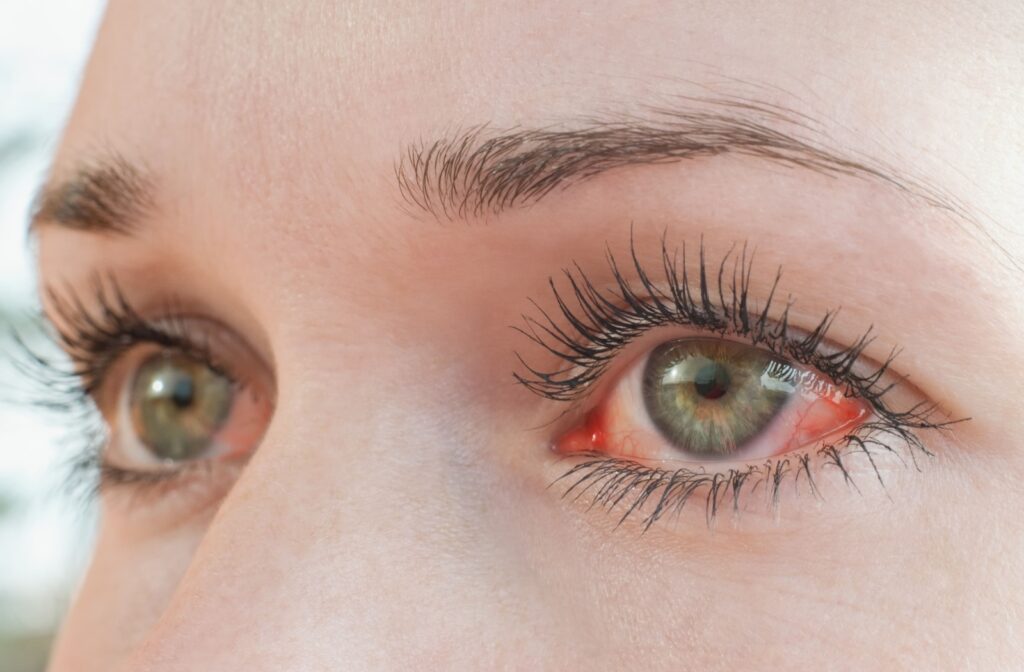If your eyes feel dry, gritty, or irritated, you might be dealing with meibomian gland dysfunction (MGD). It’s a common condition that occurs when the tiny oil glands that line your eyelids become blocked.
Meibomian gland dysfunction is a chronic condition, which means the focus is on long-term management rather than a complete cure. With consistent care, however, you can effectively control your symptoms and keep your eyes comfortable.
What Is Meibomian Gland Dysfunction?
Your eyelids are lined with small glands called meibomian glands. They produce an important oil that coats the surface of your eye and keeps your tears from drying out too quickly. MGD happens when these glands get clogged, leading to a poor quality or insufficient amount of oil.
Without this protective oil layer, your tear film becomes unstable. This instability is what causes the uncomfortable symptoms associated with dry eye disease. Identifying the signs early can help you get the support you need.
Common Signs of MGD
You or a family member may be experiencing MGD if you notice symptoms like:
- A gritty or sandy feeling in your eyes
- Dryness and irritation
- Blurry vision that comes and goes
- Watery eyes, which happen when your eyes overproduce tears to combat dryness
- Red or swollen eyelids
- Crusty eyelids, especially in the morning
A comprehensive eye exam can determine if MGD is the cause of your discomfort. We can assess your gland function and create a personalized plan. This helps you get to the root of the problem instead of just treating the symptoms.
Does MGD Ever Go Away?
Because MGD is a chronic condition, affecting the delicate oil glands along the eyelid, it typically doesn’t go away on its own. The goal of any treatment plan is to manage symptoms, improve gland function, and prevent the condition from progressing. For most people, this involves an ongoing routine to maintain eye comfort.
Think of it like managing any other chronic health concern for your family, such as allergies or sensitive skin. It requires consistent attention, but it doesn’t have to control your life. Proactive care is the key to keeping your eyes feeling good.
Why Ongoing Management Matters
Regular management is important because MGD can worsen over time if left unaddressed. Consistent care helps keep your symptoms under control and your eyes feeling more comfortable. Without a regular routine, symptoms often return or become more pronounced.
The Stages and Progression of MGD
MGD develops over time and can be grouped into different stages based on symptoms and how well the glands are working. Your experience with MGD can depend on its stage. Catching it early can make a significant difference in managing the condition effectively.
Early Signs and Symptoms
In the beginning, you might notice mild dryness or irritation. This can be more obvious after long hours of screen use, which can lead to digital eye strain, or in dry environments like an air-conditioned office. At this point, your glands might be slightly blocked, but many are still functioning.

Moderate Symptoms and Discomfort
As the condition progresses, blockages become more significant, and the oil quality can decrease. You may experience more constant dryness, redness, and blurry vision that affects your daily activities. Over-the-counter drops might not provide enough relief at this stage.
Advanced Stage and Gland Loss
In advanced stages, some meibomian glands may stop working altogether, a condition known as gland atrophy. This can lead to persistent and significant discomfort that impacts your quality of life. An optometrist can use modern diagnostic tools to view the health of your glands and recommend a plan to preserve them.
How Long Do Treatments Take to Work?
The time it takes to feel better depends on the severity of your MGD and the treatments you use. Patience and consistency are important parts of any management plan. Different approaches offer relief on different timelines.
At-Home Care Routines
Warm compresses, lid scrubs, and nutritional supplements often form the foundation of MGD care. You might notice some improvement in a few weeks with these habits. However, it can take 1–2 months of consistent daily use to experience more significant relief.
In-Office Procedures
Your eye doctor might suggest in-office treatments like TempSure Envi to help unclog the glands more effectively. Procedures like thermal pulsation or intense pulsed light (IPL) can provide relief that lasts for several months. You may need follow-up treatments to maintain the results and keep your glands healthy.
What Can Damage Meibomian Glands?
Several factors can contribute to MGD or make it worse. Understanding these factors can help you and your family protect your eye health. Many of them are a normal part of life, but awareness can help you take proactive steps.
Common Causes of Gland Blockage
Some of the most common contributors to meibomian gland issues include:
- Age is often a cause of declining gland function
- Hormonal changes, particularly during menopause
- Certain skin conditions, like rosacea
- Extended screen time, which leads to less blinking
- Wearing contact lenses for long periods
While you can’t change factors like age, you can address others. For example, taking frequent breaks from digital screens can help encourage a more regular blink rate. Discussing your lifestyle with your eye doctor can help pinpoint potential contributing factors.
Customized Dry Eye Care for Lasting Comfort
With the right management plan, you can live a full and comfortable life with MGD. It’s about finding a routine that works for you and your family. Regular check-ups with your eye doctor help track your progress and adjust your plan as needed.
At Eye Lab in Scottsdale, we’re proud to offer customized treatment plans tailored to each patient’s specific dry eye concerns, combining in-office treatments, home therapy, prescription medications, nutritional supplements, and our exclusive 12-month monitoring program. We’re here to create a comfortable and supportive experience for your entire family. Schedule a visit with us to explore your options for lasting eye comfort.





